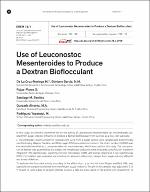Use of Leuconostoc Mesenteroides to Produce a Dextran Bioflocculant

View/
Author(s)
De La Cruz-Noriega, Magaly
Rojas-Flores, Segundo
Benites, Santiago M.
Quezada Álvarez, M.A.
Otiniano García, N. M.
Rodríguez Yupanqui, Magda
Date
2022-04-01Metadata
Show full item recordPublisher
Kaunas University of Technology
Journal
Environmental Research, Engineering and Management
Additional Links
https://www.scopus.com/inward/record.uri?eid=2-s2.0-85128194387&doi=10.5755%2fj01.erem.78.1.29591&partnerID=40&md5Abstract
In this study, we aimed to determine the in vitro activity of Leuconostoc mesenteroides var. mesenteroides isolated from sugar-industry effluents to produce a dextran bioflocculant from sucrose as a low-cost substrate. L. mesenteroides strains present in residual cane juice from a sugar factory were isolated and biochemically identified using Mayeux, Sandine, and Elliker agar (MSE) as a selective medium. The strain number 3 (LM03) was biochemically identified as L. mesenteroides var. mesenteroides, which was used for this study. The concentration of dextran was quantified by dry weight, the morphology and purity were evaluated using Fourier-transform infrared (FTIR) spectroscopy, scanning electron microscopy (SEM), and energy-dispersive X-ray spectroscopy (EDS). Flocculation was evaluated via turbidimetric assays in different pH ranges from sugar-industry effluents and doses of dextran. To evaluate the flocculant activity according to the effect of pH, a jar test kit from Phipps and Bird, USA, was used with the sample recollected from the effluent (sugar industry). The pH of the samples was adjusted to 7, 8, 9, 10 and 11, with a dose of 40 ppm (dextran dose) at a fast and slow speed of 150 and 50 rpm, respectively. To evaluate the influence of the dose of dextran, values of 5, 20 and 40 ppm were used with fast speeds of 180–150 rpm and slow speeds of 30–50 rpm, respectively. The strain (LM03) was able to produce the highest concentration of dextran (26.87 g/L) in 76 h of incubation. The presence of dextran was identified in the MSE agar after incubation and characterized by FTIR, SEM, and EDS. Besides that, we observed that the best flocculation activity was observed at a pH of 9 and a concentration of 40 ppm of dextran, with a fast agitation speed of 150 rpm for 5 min and a slow agitation speed of 50 rpm for 15 min, achieving 77.7% removal of turbidity from the sugar factory effluent. L. mesenteroides was responsible for the bioflocculation of dextran in different sugar-industry effluents.
Type
info:eu-repo/semantics/article
Rights
info:eu-repo/semantics/openAccess
Language
eng
Collections
- Ingeniería de Sistemas [332]

